International Journal of Image, Graphics and Signal Processing @ijigsp
Статьи журнала - International Journal of Image, Graphics and Signal Processing
Все статьи: 1157
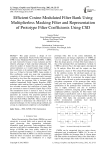
Статья научная
This paper presents a design of low complexity multichannel Nearly Perfect Reconstruction (NPR) Cosine Modulated Filter Bank (CMFB). CMFBs are used extensively because of ease realization and the inherent advantage of high stop-band attenuation. But, when the number of channel becomes large, it leads to certain limitations as it would require large number of filter coefficients to be optimized and hence longer CPU time; e.g. 32-band or 64-band CMFB. Large number of filter coefficients would also mean that computational complexity of the prototype filter is extremely increased that tends to slow down the convergence to best possible solution. Here, the prototype filter is designed using modified Interpolated Finite Impulse Response (IFIR) technique where masking filter is replaced by multiplier free cascaded structure and coefficients of model filter are converted to nearest Canonical Signed Digit (CSD). The interpolation factor is chosen in such a way that computational cost of the overall filter and different error parameters are reduced. The proposed approach thus leads to reduction in stop-band energy as well as high Side-Lobe-Fall-off-Rate (SLFOR). Three examples have been included to demonstrate the effectiveness of the proposed technique over the existing design methods and savings in computational complexity is also highlighted.
Бесплатно
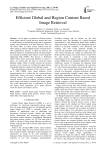
Efficient Global and Region Content Based Image Retrieval
Статья научная
In this paper, we present an efficient content based image retrieval system that uses texture and color as visual features to describe the image and its segmented regions. Our contribution is of three directions. First, we use Gabor filters to extract texture features from the whole image or arbitrary shaped regions extracted from it after segmentation. Second, to speed up retrieval, the database images are segmented and the extracted regions are clustered according to their feature vectors using Self Organizing Map (SOM). This process is performed offline before query processing; therefore to answer a query, our system does not need to search the entire database images. Third, to further increase the retrieval accuracy of our system, we combine the region features with global features to obtain a more efficient system. The experimental evaluation of the system is based on a 1000 COREL color image database. From experimentation, it is evident that our system performs significantly better and faster compared with other existing systems. We provide a comparison between retrieval results based on features extracted from the whole image, and features extracted from image regions. The results demonstrate that a combination of global and region based approaches gives better retrieval results for almost all semantic classes.
Бесплатно
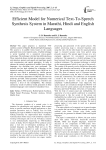
Статья научная
The paper proposes a numerical TTS-synthesis system in Marathi, Hindi and English languages. The system is in audible forms based on the sounds generated from several numeric units. A hybrid technique is newly launched for a numerical text-to-speech technology. The technique is divided into different phases. These numerical phases include pre-processing, numeric unit detection, numeric and speech unit matching; speech unit concatenation and speech generation. In order to enhance the syntactic generation of audible forms in three languages, two discipline tests were performed. The prosodic test has been obtained for evaluating on the statistical readings. Overall quality issue (OQI) test is a subjective test which is performed by various persons who are aware of three mentioned languages. On the basis of two distinct parameters of OQI test, all scores are positively provided. Initial parameter compromises with listening quality. The second parameter, awareness rate improves a level of the intelligibility. The ultimate satisfactory results of artificial sound generation in three unrelated languages were touched to humankind voice.
Бесплатно
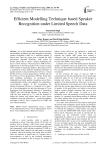
Efficient Modelling Technique based Speaker Recognition under Limited Speech Data
Статья научная
As on date, Speaker-specific feature extraction and modelling techniques has been designed in automatic speaker recognition (ASR) for a sufficient amount of speech data. Once the speech data is limited the ASR performance degraded drastically. ASR system for limited speech data is always a highly challenging task due to a short utterance. The main goal of ASR to form a judgment for an incoming speaker to the system as being which member of registered speakers. This paper presents a comparison of three different modelling techniques of speaker specific extracted information (i) Fuzzy c-means (FCM) (ii) Fuzzy Vector Quantization2 (FVQ2) and (iii) Novel Fuzzy Vector Quantization (NFVQ). Using these three modelling techniques, we developed a text independent automatic speaker recognition system that is computationally modest and equipped for recognizing a non-cooperative speaker. In this investigation, the speaker recognition efficiency is compared to less than 2 sec of text-independent test and train utterances of Texas Instruments and Massachusetts Institute of Technology (TIMIT) and self-collected database. The efficiency of ASR has been improved by 1% with the baseline by hiding the outliers and assigns them by their closest codebook vectors the efficiency of proposed modelling techniques is 98.8%, 98.1% respectively for TIMIT and self-collected database.
Бесплатно
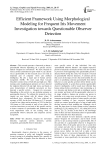
Статья научная
This research presents a framework to detect a questionable observer depending on a specific activity named “frequent iris movement”. We have focused on some activities and behaviors upon which we can classify one as questionable. So this research area is not only an important part of computer vision and artificial intelligence, but also a major part of human activity recognition (HAR). We have used Haar Cascade Classifier to detect irises of both left and right eyes. Then running some morphological operation we have detected the midpoint between left and right irises; and based on some characteristics of midpoint movement we have detected a specific activity – frequent iris movement. Depending on this activity we are declaring someone as questionable observer. To validate this research we have created our own dataset with 86 videos, where 15 individuals have volunteered. We have achieved an accuracy of 90% for the first 100 frames or 3.33 seconds of each of our videos and an accuracy of 93% for the first 150 frames or 5.00 seconds of each of our videos. No work has been done yet on basis of this specific activity to detect someone as questionable and furthermore our work outperforms most of the existing work on questionable observe detection and suspicious activity recognition.
Бесплатно
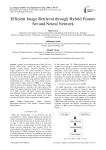
Efficient image retrieval through hybrid feature set and neural network
Статья научная
Images are an important part of daily life. Any person cannot easily control the huge repository of digitally existing images. Extensive scanning of the image database is very much essential to search a particular image from the huge repository. In some cases, this procedure becomes very exhaustive also. As a result, if a count of ten thousand, lakhs or considerably more images are included in the image database, then it may be transformed into a tedious and never-ending process. Content-based image retrieval (CBIR) is a technique, which is used for retrieving an image. This type of image retrieval procedure is centered on the real content of the image. This paper proposed a model of the hybrid feature set of Haar wavelets and Gabor features and analyzed with different existing models image retrieval. Content-based image retrieval using hybrid feature set of Haar wavelets and Gabor features superiors on other models.
Бесплатно
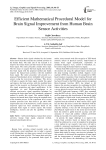
Статья научная
Human brain signals obtained by the human brain sensor electrodes measure the cerebral activities on the human brain. The main aim of our research is to improve the human brain activities based on the human brain signal. The entire procedure contains three steps. The first step is to acquire the brain signal, then develop this brain signal with the proposed method and finally improve the human brain activities with this modified brain signal. The entire procedure will proceed in a proposed Neuroheadset device embedded with necessary sensors using the non-invasive technique. This device will help to acquire the brain signal, modify this signal and improve the brain activities with this modified brain signal. In this research, we illustrated the first two steps like signal acquisition and signal modification. In the experiment, we used Electroencephalogram as an efficient non-invasive signal acquisition technique for acquiring the brain signal and also introduced a proposed method to modify this signal. This method helped to improve the human brain signal using the required times of the iteration process. In the experiment level, several iteration processes have been done to get above 90% improvement rate of the brainwaves. In this research, the improved signal has been considered based on the generated brain signal in various aspects like human intelligence, memory and also the capability of better feelings.
Бесплатно
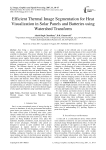
Статья научная
Sun being a non-conventional source of energy produces solar energy which is clean and available in abundance. The power obtained from solar panels is used to charge solar batteries and utilized to get continuous power supply. Solar panels are installed in open atmosphere and when subjected to different weather conditions involve many problems such as damage to different components, loss of power generation and heating. The different deposits on solar panel surface such as cement deposits, bird droppings increase temperature of deposited area and produce heating. The heating in solar panels develop hot spots. Batteries placed in a battery room attain high temperature and produce heat. This overheating affect working and performance of solar panels and batteries. These effects of heat are not visible by naked eye but are visible in thermal images, captured using thermal imaging camera. This paper focus on implementing an efficient visualization technique to segment the desired portion of heat from thermal images of solar panels and batteries using watershed transform.
Бесплатно
Статья научная
We are proposing a unique novel algorithm for tracking human face(s) in different background video sequences. In the beginning, Eigen features and corner points are extracted from the detected face(s). HOG (Histograms of Oriented Gradients) features are isolated from corner points. Eigen and HOG features are combined together. Using these combined features, point tracker keeps track of the face(s) in the frames of the video sequence. Proposed algorithm is being tested on challenging datasets video sequences with technical challenges such as partial occlusion (e.g. moustache, beard, spectacles, helmet, headscarf etc.), changes in expression, variations in illumination and pose; and measured for performance using standard metrics such as accuracy, precision, recall and specificity. Experimental results clearly indicate the robustness of the proposed algorithm on all different background challenging video sequences.
Бесплатно
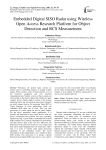
Статья научная
Nowadays, the ground radar systems are mostly used for controlling airspace or making weather images. These systems consist of large antenna, a lot of the electronic equipment and very powerful computational unit. Smaller versions of these systems are often carried on the board of planes but still they are quite complex devices. Much simpler versions of the systems mentioned above but still using the same basic principles are small compact devices for measuring Target RCS or Target detection. In these applications, small size embedded SDR radar can be used. Then real time processing of a radar signal can also be much simpler. For the above mentioned simple applications, it is possible and reasonable to have small devices with low power consumption that perform real time correlation based processing. Typical today's embedded FPGA based SDR solutions have enough computational performance and their electric input is also very low. Moreover, the dimensions of the processor boards are very compact and they can be easily integrated into very small cases. That's why it is good to transfer radar signal processing algorithms to the embedded system. The recent development in the digital Radar is now molded in these SDR systems. Our motivation is to design a Spread Spectrum based digital SDR radar which is very small in size and may be a low cost solution where we can bypass all the huge instrumentation complexity. This type of solution is now popular for defense organizations, even can be used in human daily life.
Бесплатно
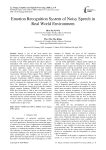
Emotion Recognition System of Noisy Speech in Real World Environment
Статья научная
Speech is one of the most natural and fundamental means of human computer interaction and the state of human emotion is important in various domains. The recognition of human emotion is become essential in real world application, but speed signal is interrupted with various noises from the real world environments and the recognition performance is reduced by these additional signals of noise and emotion. Therefore this paper focuses to develop emotion recognition system for the noisy signal in the real world environment. Minimum Mean Square Error, MMSE is used as the enhancement technique, Mel-frequency Cepstrum Coefficients (MFCC) features are extracted from the speech signals and the state of the arts classifiers used to recognize the emotional state of the signals. To show the robustness of the proposed system, the experimental results are carried out by using the standard speech emotion database, IEMOCAP, under various SNRs level from 0db to 15db of real world background noise. The results are evaluated for seven emotions and the comparisons are prepared and discussed for various classifiers and for various emotions. The results indicate which classifier is the best for which emotion to facilitate in real world environment, especially in noisiest condition like in sport event.
Бесплатно
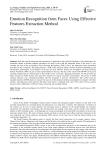
Emotion Recognition from Faces Using Effective Features Extraction Method
Статья научная
With the rapid development and requirement of application with Artificial Intelligent (AI) technologies, the researches related to human-computer interaction are always active and the emotional status of the users is very essential for most of the environment. Facial Emotion Recognition, FER is one of the important visual information providers for the AI systems. This paper proposes a FER system using an effective feature extraction methodology and classification technologies. Local features of the face are more effective features for recognition and Scale Invariant Feature Transform, SIFT can give a better representation of the face. The bag of the visual word (BOVW) is the good encoding method and the advancement of that model Vector of Locally Aggregate Descriptor, VLAD provides the better encoder for SIFT features and used these benefits for feature extraction environments. The power of SVM includes unknown class recognition problems and this advantage is used for classification. This system used the standard basement JAFEE dataset to measure the success of the proposed methods and prepared to compare with other systems. The proposed system achieves the better result when it compared with some of the other previous systems because of the combination of effective feature extraction and encoding method.
Бесплатно
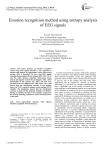
Emotion recognition method using entropy analysis of EEG signals
Статья научная
This paper proposes an emotion recognition system using EEG signals, therefore a new approach to emotion state analysis by approximate (ApEn) and wavelet entropy (WE) is described. We have used EEG signals recorded during emotion in five channels (FP1, FP2, T3, T4 and Pz), under pictures induction environment (calm-neutral and negative excited) for participants. After a brief introduction to the concept, the ApEn and WE were extracted from two different EEG time series. The result showed that, the classification accuracy in two emotion states was 73.25% using the support vector machine (SVM) classifier. The simulations showed that the classification accuracy is good and the proposed methods are effective. During an emotion, the EEG is less complex compared to the normal, indicating reduction in active neuronal process in the brain.
Бесплатно
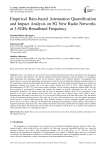
Статья научная
Today, rain remains one key and well-known natural phenomenon that offsets and attenuates the propagated radio, microwave, and millimeter-wave signals at different transmission frequencies and wavelengths over propagation paths. Specialised rain attenuation studies can be utilized to analyze their stochastic behavior on propagated radio signals and also come up with appropriate rain attenuation model for network application planning and optimisations. In this contribution, empirical rainfall depths data has been acquired, effectively categorized, and employed to examine the implicative intensity level trends over a ten years period, starting from 2011 to 2020. More importantly, the Recommendation ITU-R P.1511 power-based model combined with the acquired categorized rainfall depths data has been explored to prognostically estimate and quantity the amount of specific attenuation loss due over 3.5G transmission frequency. The results reveal that the level of attenuation attained versus 0.01% percentage of time depends on the type of rain intensity levels (heavy rain, very heavy rain, extremely heavy rain), which in turn is dependent upon rain depth or rate drop sizes. As a case in point, 0.001 percent of the time due to heavy rain, the amount of specific attenuation attained stood at 2dB, while for very heavy and extremely heavy rain, the specific attenuation levels amount to 2.3dB and 4dB respectively. These different amounts of specific attenuation simplify imply that the heavier the rain, the more scattering, and absorption the propagated electromagnetic signals undergo, thus leading to degraded and higher attenuation levels. The empirical based-rain attenuation quantification and impact analysis method explored in this paper will significantly provide radio network engineers with the best way to monitor and evaluate the radio attenuation effect over a propagation channel.
Бесплатно
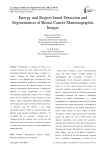
Energy and Region based Detection and Segmentation of Breast Cancer Mammographic Images
Статья научная
Telemedicine is growing and there is an increased demand for faster image processing and transmitting diagnostic medical images. A region is a popular technique for image segmentation. We introduce a new approach that overcomes the close boundary initialization problem by reformulating the external energy term. We treat the contour as a mean curve of the probability density function. A widely used approach to image segmentation is to define corresponding segmentation energies and to compute shapes that are minimizes of these energies. In many medical image segmentation applications identifying and extracting the region of interest (ROI) accurately is an important step .We present a new image segmentation process, which can segment images with different image intensity distributions efficiently. To accomplish this, we construct a function that is evaluated along the evolving curve. In this cost, the value at each point on the curve is based on the analysis of interior and exterior means in a local neighborhood around that point.
Бесплатно
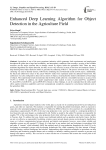
Enhanced Deep Learning Algorithm for Object Detection in the Agriculture Field
Статья научная
Agriculture is one of the most prominent industries which guarantee food requirements and employment throughout the globe due to huge land availability, and atmospheric conditions. But nowadays, security of the available resources are the major concerns due to damage caused by objects inside the agriculture field. There are many traditional algorithms for object detection, but they are not very effective in terms of real time environments. Hence, a deep learning-based object detection model is generated by enhancing YOLOv3. The process involved firstly, k-means clustering was used to identify clusters, followed by modifying the convolutional neural network layers. Additionally, the batch and subdivision values of the actual YOLOv3 model were optimized under the darknet53 framework. The architecture was also configured to detect eleven classes of objects, ensuring that the model could identify a broad range of objects. The experimental results demonstrate that the Delta model achieved a remarkable increase in accuracy from 75.19% to 95.86%. In addition, the model outperformed other models in terms of precision(97%), recall(96%), F1_Score(96%), IoU(80.81%), and mAP(95.86%). Based on these findings, it can be concluded that the delta model offers superior detection capabilities and lower computational complexity compared to conventional methods used in the agriculture field.
Бесплатно
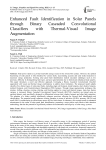
Статья научная
Solar power stands as a pivotal renewable energy source for the twenty-first century. However, the optimal functioning of solar panels is often hindered by various faults, necessitating accurate and early defect detection to maximize energy production. Existing solar panel fault identification models encounter challenges such as low precision, difficulty in distinguishing fault types, and poor generalization due to limited and unbalanced data samples. This paper introduces a novel and effective approach, leveraging a Binary Cascaded Convolutional Classifier augmented with visual and thermal image combinations to address these limitations. The proposed model adeptly classifies five distinct types of solar panel faults, including single cell hotspots, diode hotspots, dust/ shadow hotspots, multicell hotspots, and Potential-Induced Degradation (PID) hotspots. Through image augmentation techniques like rotation, shifting, sheering, resizing, jittering, and blurring applied to visual and thermal images, inter-class feature variance is increased. Binary Cascaded Convolutional Neural Network (BCCNN) classifiers are trained using an enriched dataset, each specifically designed to differentiate between dust/ shadow hotspots and other fault categories. The adoption of a binary method significantly enhances precision, allowing for focused fault identification and classification. The proposed model surpasses existing literature in terms of precision (99.8%), accuracy (98.5%) and recall (98.4%), underscoring its effectiveness across all five fault classes. In summary, this research marks a substantial advancement in the realm of solar panel fault identification, presenting a more precise and effective fault detection methodology that has the potential to significantly enhance the maintenance and longevity of solar energy systems.
Бесплатно
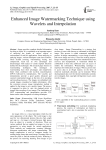
Enhanced Image Watermarking Technique using Wavelets and Interpolation
Статья научная
Image provides complete detailed information for thing or object. It is considered as an important aspect of analyzing the details of various objects or environments of real life applications. From analyzing or studying images, various techniques come into existence. These include zooming, watermarking, hazing, and compression. Each has its own advantages and disadvantages with respect to various implicit functions defined for the techniques. The research paper focuses on watermarking techniques. The techniques of watermarking have their advantages and outperforms better when combined with wavelets transformations (DWT) followed by interpolations. The wavelets and interpolations provide a good quality enhanced and zoomed watermarked images at the time of its encoding and decoding processes. The images are embedded with sample images considered as hidden information. After the extraction process image interpolation method is applied to the image to get a quality image. The process is suggested in order to view the changed pixels of images after encoding of two images. The combination of DWT watermarking and interpolation provides 52% better results when compared to existing techniques.
Бесплатно

Enhanced Performance of Multi Class Classification of Anonymous Noisy Images
Статья научная
An important constituents for image classification is the identification of significant characterstics about the specific class to distinguish intra class variations. Since performance of the classifiers is affected in the presence of noise, so selection of discriminative features is an important phase in classification. This superfluous information i.e. noise, e.g. additive noise may occur in images due to image sensors i.e. of the constant noise level in dark areas of the image or salt & pepper noise may be caused by analog to digitals conversion and bit error transmission etc.. Detection of noise is also very essential in the images for choosing appropriate filter. This paper presents an experimental assessment of neural classifier in terms of classification accuracy under three different constraints of images without noise, in presence of unknown noise and after elimination of noise.
Бесплатно

Enhanced Surgical Mask Recognition Using EfficientNet Architecture
Статья научная
The research article presents a robust solution to detect surgical masks using a combination of deep learning techniques. The proposed method utilizes the SAM to detect the presence of masks in images, while EfficientNet is employed for feature extraction and classification of mask type. The compound scaling method is used to distinguish between surgical and normal masks in the data set of 2000 facial photos, divided into 60% training, 20% validation, and 20% testing sets. The machine learning model is trained on the data set to learn the discriminative characteristics of each class and achieve high accuracy in mask detection. To handle the variability of mask types, the study applies various versions of EfficientNet, and the highest accuracy of 97.5% is achieved using EfficientNetV2L, demonstrating the effectiveness of the proposed method in detecting masks of different complexities and designs.
Бесплатно

